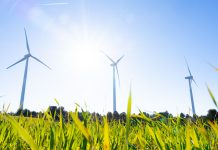Here, we learn about the research of Dr Sanju A. Sanjaya, Director, of the West Virginia State University Energy and Environmental Science Institute
Dr Sanju A. Sanjaya received a PhD in 2003 from the University of Mysore, Mysore, India, on tree improvement and biotechnology. That same year, he joined the Agricultural Biotechnology Research Center at Academia Sinica, in Taipei, Taiwan as a postdoctoral fellow working on the genetic engineering of orchids and tomatoes, for biotic and abiotic stress tolerance. He has worked at the Great Lakes Bioenergy Research Center at Michigan State University as a Senior Research Associate on a project focused on increasing energy density in vegetative tissues. His credentials include three patent applications, 20 papers in refereed journals, six published book chapters and eight published reviews.
Dr Sanjaya’s lab leads an active research program to design photosynthetic organisms with enhanced bioenergy and industrial compounds for higher production, profitability and sustainability. Dr Sanjaya’s research group uses bioinformatics, biochemical, molecular, cell biology and genetic engineering approaches to understand the primary metabolism mechanisms in plants and microalgae. Dr Sanjaya’s lab also aims to advance the use of photosynthetic organisms to address water quality issues and phytoremediation.
Energy & environment research
The West Virginia State University Energy and Environmental Science Institute (WVSUEESI) mission is to conduct basic and applied interdisciplinary research in energy and the environment to generate technology and knowledge.
“Our goal is to partner with public and private sectors, so we can work together to address pertinent energy and environmental issues for West Virginia,” says WVSUEESI Director, Dr Sanjaya. Those issues include researching the feasibility and sustainability of alternative energy sources for the Mountain State as government regulation and environmental concerns continue to cast resources such as natural gas and coal in the national spotlight.
Those new energy sources include renewable resources from plant-based biomass. Scientists at WVSU conduct ongoing projects focusing on feedstock improvement, biofuels and bioproducts; genomics; bioremediation, environment and sustainability. One project involves increasing the production of plant oils in the biomass of bioenergy crops that can be used to produce biodiesel and replanted onto formerly mined areas to determine how well crops will grow on reclaimed land.
One of the goals of the WVSUEESI is to generate technologies and provide hands-on research opportunities to students and science-based outreach opportunities for K-12 youth; Research and Teaching Graduate Assistantships in the MS Biotechnology Program; the Research Rookies Program in energy-related research; Agricultural and Environmental Science Careers for Non-Traditional Students (AESCONTS) throughout the region in the hope of generating the tomorrow’s scientists.
“I’ve always wanted to progress professionally and academically and to enrich my previous experience working with energy and environmental science,” Dr Sanjaya explains. “One of my biggest interests in being at WVSU is the opportunity to work in a team, with hard-working and smart students and scientific community.”
Dr Sanjaya hopes the research will ultimately attract industry and academic partners to the region, enhancing economic development and workforce opportunities.
A true leader in the classroom
In addition to his ambitious research, Dr Sanjaya is a true leader in the classroom at WVSU who enjoys interacting with and motivating his students. He goes on to provide further detail: “I often bring my students to the lab to do the real work they’re learning about in the classroom. It’s a different opportunity for learning because my research is very hands-on.”
Ever the visionary, Dr Sanjaya not only hopes his research will motivate West Virginians to stay in the State, but he looks forward to the day that young people will flock to West Virginia to work in science and research.
Dr Sanjaya adds: “If my research is even a small piece of the puzzle that helps West Virginia, then I am happy.”
Innovative research & technology revolutionising agriculture
As we enter an era where global food production is likely to double as the human population increases, sharing prime agricultural lands and resources for food and energy production becomes an even greater challenge. A breakthrough technology that enables the cultivation of an energy crop on a vast area of marginal lands can address these issues. Dr Sanjaya uses a gene-editing technique called CRISPR that gives him the ability to alter genes in plants, enabling them to grow on mountainous terrain, in soil with low nutrients, and even under drought conditions. This research is considered cutting edge, but has already proven viable in other parts of the world.
Improving the nutritional & energy content of crops
Dr Sanjaya then turns the discussion towards current research when it comes to improving the nutritional and energy content of crops. Dr Sanjaya considers why this is necessary for society today and how this incorporates gene technology.
“Currently, the majority of the oils used in biodiesel production come from the seeds of plants,” Dr Sanjaya comments. Biodiesel is a form of diesel fuel derived from plants or animals. “By increasing the energy provided by plants, the land required to grow both biodiesel and food crops could be significantly reduced,” he adds.
Plants accumulate oils within the tissue of the seeds to help with the energy-intensive process of germination and growth of new seedlings. By harnessing the mechanism used by the plant to send and store these oils within the seeds, Dr Sanjaya and his team aim to create new breeds of plants that accumulate higher amounts of oils within the rest of the plant’s vegetative tissue – the leaves, stems and roots.
To increase the amount of oils stored in the vegetative tissue of plants, Dr Sanjaya and his colleagues have taken a two-pronged approach. Plants can only capture a finite amount of carbon in any period, so increasing the amount of oils created and stored necessarily requires a reduction in the amount of starch being produced.
First, the researchers used advanced molecular techniques to manipulate the genes involved in producing and accumulating oils called triglycerides – using the model plant Arabidopsis thaliana. This flowering plant species is related to mustard, cabbage and radishes and is ideal for testing and refining genetic techniques because of its small size and short generation times.
By increasing the activity of a gene controlling seed oil production, Dr Sanjaya’s team created a version of the plant that tends to store these oils within the vegetative tissue.
Following this, the team focused on a gene involved in starch production. They found that when this gene was edited to exhibit decreased activity, more carbon was left available to be routed into the production of oils. The resulting plant that possesses both edited genes divides more of the carbon captured during photosynthesis into oils than into starch.
“Our long-term goal is to develop energy-dense bioenergy crops that can grow on vast areas of reclaimed coal mine lands of West Virginia and the Appalachian coal basin,” Dr Sanjaya comments.
Ultimately, he says, this work could bring sustainable agriculture and sustainable energy-related industry to the State.
FUNDING: USDA NIFA and NSF RIA
Please note: This is a commercial profile
© 2019. This work is licensed under a CC BY 4.0 license.











